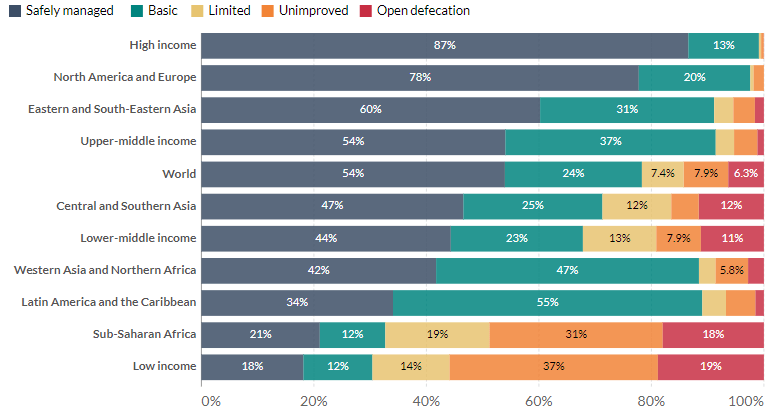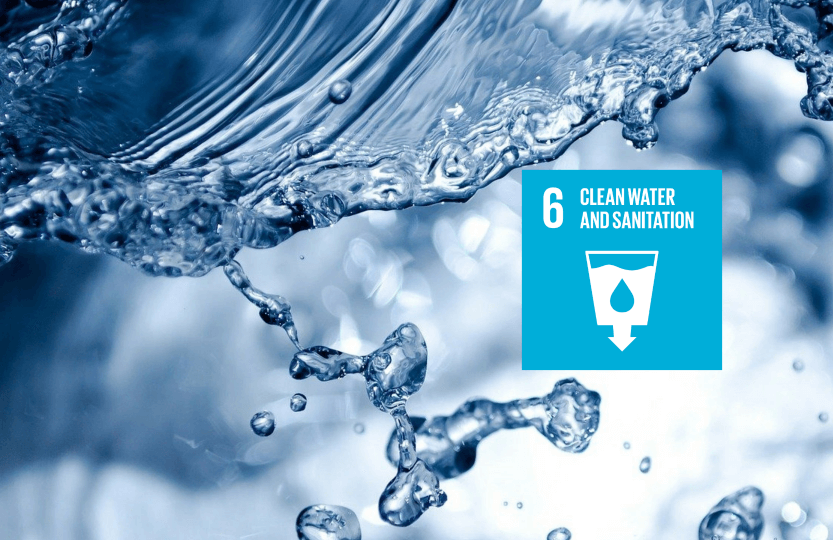Water is a natural resource that is indispensable for life on the planet. Known as the Blue Planet, Earth has 71% of its surface covered by water. Nevertheless, out of the total amount of water present on our planet, 97% is in the oceans and only 3% is freshwater; this last comprising water in glaciers and ice caps (2%), aquifers (0.62%), lakes (0.009%), atmosphere (0.001%), and rivers (0.0001%) [1]. Thus, human consumption and other multiple uses can be highly demanding for freshwater supply, which is not equally distributed across the globe. Besides water scarcity, aquatic ecosystems are highly impacted from the effects of pollution, eutrophication, contamination of chemicals, and illegal water drilling and withdrawals as well.
Water is also a vehicle for many bacteria, protozoa and viral pathogens, which can cause diseases associated with gastroenteritis, and even other severe illnesses, such as meningitis and hepatitis [2]. Furthermore, with climate change influencing higher frequency of extreme events, the quantity and quality of water is compromised by both droughts and floods. Hence, the Sustainable Development Goal 6 aims to ensure availability and sustainable management of water and sanitation for all, encompassing six targets to achieve universal and equitable access to safe and affordable drinking water, as well as sanitation and hygiene, improving water quality, increasing water efficiency in the different sectors, implementation of an integrated water resources management, and protection and restoration of ecosystems [3].
Clean Water, Sanitation, and Health
In 2020, officials recorded that 2 billion people (or 26% of the global population) lack access to safe potable water, and 3.6 billion people (or 46% of the global population) do not have access to safely managed sanitation facilities [4]. Access to clean drinking water and sanitation infrastructure is closely linked to health. In fact, a study conducted by the World Health Organization (WHO) in 2012 concluded that every US$1.00 invested in sanitation would result in a return of US$5.50 in lower costs for health systems, increasing productivity, and preventing premature deaths [5]. According to WHO data, the region most affected by sanitation deficiency is Sub-Saharan Africa, where 12% of the population has access to basic sanitation facilities, 19% has a limited structure available, 31% has the use of an unimproved system, and 18% practices open defecation (Figure 1). Additionally, other regions that have less than 50% of their population with access to safely managed sanitation systems include: Latin America and Caribbean, Western Asia and Northern Africa, and Central and Southern Asia.

Source: WHO/UNICEF Joint Monitoring Program for Water Supply and Sanitation, OurWorldInData[6]
Experts estimate that the absence of proper water and sanitation facilities is the leading cause of the death for 827,000 people in low- and middle- income countries [5]. The main associated diseases are diarrhoea (responsible for 60% of the aforementioned number of deaths), cholera, typhoid, dysentery, hepatitis A, and polio, besides illnesses caused by intestinal worms, such as schistosomiasis and trachoma, and malnutrition [5; 7]. A sad reality, considering that most of these diseases can be easily preventable with access to potable water and to adequate sanitation systems. For instance, improved water and sanitation access could avert the deaths of children under age 5, which is estimated to be 297,000, as well as stunting [5].
Furthermore, the current reality of precarious water and sanitation systems in many places around the world makes the fight against the spread of COVID-19 even more challenging. Adequate hygiene measures are key to prevent the spread of the virus. However, in low income countries, there is a high deficiency in water services to provide this benefit of proper hygiene. In Sub-Saharan Africa, for example, only 26% of its population have access to basic handwashing facilities (soap and water), 40% have limited access (i.e. without water or soap), and 34% completely lack any service or alternative [6]. Moreover, the presence of SARS-CoV-2 RNA has been reported in wastewater, although the knowledge on the infectivity of the virus via wastewater is limited at the moment [8].
Clean Water, Sanitation, and Climate Change
Climate change represents a serious threat to the provision of clean freshwater worldwide. This is largely due to the finding that climate change is projected to cause shifts in patterns of precipitation and evaporation, as well as alter the frequency and severity of extreme weather events [9, 10]. Estimates suggest that modifications in surface water area indicative of drought and flooding events are taking place in about one-fifth of the world’s river basins [11]. Droughts decrease water availability while maintaining or increasing demand, leading to water scarcity. Without the water they need for drinking, hygiene, or other uses like agriculture, people suffer. The little-available water can be more likely to contain pollutants, which can impact human health [12]. People may be driven to drink contaminated water, which results in a surge in waterborne diseases. With little or no rainfall and no water for irrigation, agriculture and livestock are negatively affected, and food supply also becomes endangered [13]. Additionally, drought-driven lack of water can cause conflict among users, as they compete for a dwindling resource. When conflict arises, it can impact and divert resources from the community’s infrastructure, including systems to maintain and sanitize fresh water [14].
Like too little water, too much water is also a problem. When extreme events like flooding occur, there can be negative consequences for water quality and sanitation systems [15]. Flooding events have been associated with the presence of higher levels of microbes and pathogens, as well as metals and chemical and organic contaminants [16, 17]. Increased surface runoff associated with heavy rainfall can pick up sediment, contaminants like fertilizer, and other pollutants, which then might be transferred to a community’s water source [15, 17]. Heavy rainfall and flooding can also overload and damage infrastructure and sanitation systems, leaving communities with contaminated, unsafe water [18].
Sustainable use of water resources, along with resilient infrastructure, forms a basis for gaining and maintaining access to clean water and sanitation for vulnerable communities across the world. An integrated, participatory approach to management, combined with risk assessment and adaptive solutions, including community lead and/or nature-based solutions, can increase water security and safety [19]. Strengthening cooperation between communities, countries, and other stakeholders, including with transboundary water management, promotes knowledge-sharing, harmonises the use of water resources, and ultimately augments the effectiveness of water governance. Additionally, increasing effective climate action and the protection of natural ecosystems will enhance the stability of the earth system and, thus, of water resources [20, 21].
Conclusions
Ensuring the availability and accessibility of clean water to all, particularly in the face of ongoing climate change, is a key challenge moving forward. Access to sanitation systems and sufficient quantities of clean, quality water is paramount to human health and helps to fight diseases, including COVID-19. Prevention and investments in safely and sustainably managed water systems and sanitation facilities improve health and quality of life, besides contributing to a positive feedback in the economy for the health system. It is important to have this awareness and continue to develop technologies, form connections among various stakeholders, and engage in action in order to make progress towards the achievement of the targets of the SDG 6 for a universal and equitable access to water and sanitation systems.
References
[1] Bureau of Reclamation: Water Facts – Worldwide water supply
[2] Gall, A.M., Mariñas, B.J., Lu, Y., & Shisler, J.L. (2015). Waterborne Viruses: A Barrier to Safe Drinking Water. PLoS Pathogens, 11(6): e1004867
[3] United Nations: Goal 6 – Ensure access to water and sanitation for all
[5] World Health Organization: Sanitation Fact sheets
[6] Our World in Data: Clean water and sanitation
[7] World Health Organization: Water, sanitation and hygiene – exposure
[8] Kitajima et al. (2020). SARS-CoV-2 in wastewater: State of the knowledge and research needs. Science of The Total Environment 739: 139076.
[9] IPCC, 2014: Climate Change 2014: Synthesis Report. Contribution of Working Groups I, II and III to the Fifth Assessment Report of the Intergovernmental Panel on Climate Change [Core Writing Team, R.K. Pachauri and L.A. Meyer (eds.)]. IPCC, Geneva, Switzerland, 151 pp.
[10] Konapala, G., Mishra, A.K., Wada, Y. et al. (2020). Climate change will affect global water availability through compounding changes in seasonal precipitation and evaporation. Nature Communications 11: 3044.
[11] UN Summary Progress Update 2021: SDG 6 – Water and sanitation for all;
[12] Benotti, M. J., Stanford, B. D., & Snyder, S. A. (2010). Impact of drought on wastewater contaminants in an urban water supply. Journal of environmental quality 39(4): 1196–1200.
[13] Centers for Disease Control and Prevention: Health Implications of Drought;
[14] Levy, B. S., & Sidel, V. W. (2011). Water rights and water fights: preventing and resolving conflicts before they boil over. American journal of public health, 101(5): 778–780.
[15] Erickson, T. B., Brooks, J., Nilles, E. J., Pham, P. N., & Vinck, P. (2019). Environmental health effects attributed to toxic and infectious agents following hurricanes, cyclones, flash floods and major hydrometeorological events. Journal of toxicology and environmental health. Part B, Critical reviews 22(5-6): 157–171.
[16] Yard, E. E., Murphy, M. W., Schneeberger, C., Narayanan, J., Hoo, E., Freiman, A., Lewis, L. S., & Hill, V. R. (2014). Microbial and chemical contamination during and after flooding in the Ohio River-Kentucky, 2011. Journal of environmental science and health. Part A, Toxic/hazardous substances & environmental engineering, 49(11): 1236–1243.
[17] Sun, R., An, D., Lu, W., Shi, Y., Wang, L., Zhang, C., Zhang, P., Qi, H., & Wang, Q. (2016). Impacts of a flash flood on drinking water quality: case study of areas most affected by the 2012 Beijing flood. Heliyon 2(2): e00071.
[18] McCluskey, J. 2001.Water supply, health and vulnerability in floods. Waterlines. 19(3): 14-17.
[19] Agarwal, A., de los Angeles, M. S., Bhatia, R., Chéret, I., Davila-Poblete, S., Falkenmark, M., Gonzalez-Villarreal, F., Jønch-Clausen, T., Aït Kadi, M., Kindler, J., Rees, J., Roberts, P., Rogers, P., Solanes, M. & Wright, A. (2000). Integrated Water Resources Management. GWP-TAC Background Papers (4). 43 pp.
[20] UNECE – Water and adaptation to climate change
[21] IUCN – Water and climate chance issues brief











Improved water supply, sanitation, and water resource management can significantly lower poverty while also boosting a country’s economic growth.